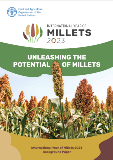International Year of Millets ends with pledge to build on its success
FAO and partners begin a new chapter in collaboration and advocacy

©FAO/Alessandra Benedetti
The Food and Agriculture Organization of the United Nations (FAO) marked the official closure of the International Year of Millets 2023 with a ceremony that celebrated the Year’s achievements and committed to continuing the momentum.
Over 200 people attended the hybrid event which was held at FAO ‘s headquarters in Rome and on Zoom.
FAO Director-General, Mr. QU Dongyu, said the Year had reminded people about the value of millets and their untapped potential to transform agrifood systems. “This International Year has helped us rediscover the many reasons these crops should be in our fields, in our markets, and on our tables,” he said. Qu said millets were low-input crops that could be grown in dryland areas, where more than 2 billion people live.
The Director-General called for more research and development, public and private investment and support for the sustainable production and consumption of millets.
In her keynote address, Ms. Maninder Kaur Dwivedi, the Additional Secretary of India’s Department of Agriculture and Farmers Welfare, said India had collaborated with FAO in celebrating the Year with the aim to expand millets global footprint and draw attention to its unique nutritional qualities and climate resilient traits.
Dwivedi spoke of the “pivotal role” of millets in sustainable food value chains saying India had showcased the ancient grains, known as Shree Anna or the ‘honoured grains’, to the global community.
“We successfully reached a multitude of stakeholders across the world with a global outreach of more than 200 million, leveraging international and national events, expos, and activities at the grassroot level,’’ she said, while noting the success of the flagship Global Millets (Shree Anna) Conference attended by Indian Prime Minister, Narendra Modi, in March.
India also launched ‘MAHARISHI’ or the Millets And Other Ancient Grains International Research Initiative, which aims to build collaboration between the public and private sector, and support research and knowledge transfer about millets through capacity-building initiatives and international research conferences.
Mr. Yaya Adisa Olaitan Olaniran, Minister and Permanent Representative of the Federal Republic of Nigeria to FAO, presented the second keynote address delivering a continental perspective from Africa.
He said the Year had laid the groundwork for expanding awareness about millets and their potential to increase production and consumption.
Mr. Olaniran said that a boost in millets production would eliminate mass imports of wheat, raise farmers’ incomes and enable them to live well, while fulfilling their obligations to future generations. Referring to himself as a product of millets, having consumed them as a child, Mr. Olaniran summarized the year-long activities held in several countries and spoke of his desire to see urban dwellers and the youth incorporate millets into their diets.

©️FAO/Giuseppe Carotenuto
The way forward for millets
The Director General of International Crops Research Institute for the Semi-Arid Tropics (ICRISAT), Ms. Jacqueline Hughes, spoke of the many achievements and more than 100 events in 35 countries that had raised awareness and engagement.
Looking ahead, Hughes focused on the need to strengthen collaboration and maintain the momentum that had been generated to transform agrifood systems.
She said it was critical to safeguard invaluable genetic resources, support sustainable practices and invest in research initiatives.
By promoting millets and reclaiming lost market opportunities from rice, wheat, and maize, we can open new revenue streams for smallholders and value chain actors, Hughes said.
“Millets can play a role in enhancing livelihoods and safeguarding the environment, striking a delicate balance between prosperity and sustainability,” she said
In her closing remarks, FAO Deputy-Director General Ms. Beth Bechdol thanked the Steering Committee, the Secretariat, partners and colleagues, while stressing the need to continue efforts to advance the transformation of agrifood systems with millets as a key option.
“While this event is the close of the International Year of Millets, it marks the beginning of their recognition as climate-resilient crops and nutritious foods,” she said.
Bechdol said FAO was partnering with Members through the One Country, One Priority Product Initiative, to promote teff in Ethiopia, millets in India and sorghum in Somalia and South Sudan.
Through the GEF-7 Drylands Sustainable Landscapes Impact Program, FAO is also supporting 11 countries to achieve land degradation neutrality with a focus on neglected species like millets and sorghum in Zimbabwe.
Thanks to the South-South Cooperation with China, Bechdol said FAO supported the development of new varieties of foxtail millet and sorghum in Uganda and had partnered with the International Atomic Energy Agency on a five-year research programme to improve genetic traits for pearl, finger and proso millets.
The moderator of the event, Mr. Yurdi Yasmi, FAO Special Coordinator/Deputy Director, guided the audience on a tour of millets from around the world by sharing facts and showing examples of millet products.


